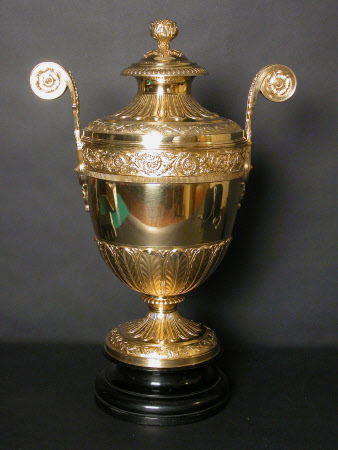Trophy cup
Edward Barnard & Sons (fl.1829 - 1977)
Category
Silver
Date
1811
Materials
Silver-gilt
Measurements
430 x 335 x 200 mm; 115 oz t (Wt)
Place of origin
London
Order this imageCollection
Osterley Park and House, London
NT 772326.1
Caption
Rebecca Emes was a partner in one of the largest manufacturing silversmiths of its day. Emes and Barnard’s London workshop created pieces for its own aristocratic customers and also supplied major retailers, including the prestigious royal goldsmiths Rundell, Bridge & Rundell. Following the death of her husband, John (1762–1808), like Louisa Courtauld and many other women before her, Emes took over his business. Her first mark was registered in 1808, jointly with William Emes, her husband’s executor, probably to ease the process of arranging John’s estate. A few months later she registered her first mark with her partner, Edward Barnard (d.1855), who was a reliable and known hand, having previously worked as foreman of the company for John. Together, they developed a highly successful business, supplying silver across Britain and overseas, including to the USA and India. The range of products the firm created was impressive and meant it could capitalise on a market of wealthy buyers hungry for gleaming silver to adorn their homes. It also shifted cannily as styles and habits evolved, introducing new patterns and forms in response to consumer demand. Emes and Barnard produced tea and coffee sets; dining accoutrements for the fashionable table, such as cruets, tureens and toast racks; and more personal practical items, such as inkstands and chamber candlesticks. Some of Emes and Barnard’s most spectacular commissions were presentation pieces. Racing cups formed an important element of this work and the cup at Osterley, the prize for the winner at the Chelmsford Races in 1813, is an elegant example.
Summary
A sporting trophy in the form of a stem silver gilt cup and cover, the circular base with foliate band, the body with foliate decoration in relief and finely chased applied foliate scroll band, the handles in Egyptian style, the double domed cover with similar decoration and pomegranate finial.
Provenance
Jersey bequest, March 1993.
Marks and inscriptions
Inscribed under the base, 'Chelmsford Races 1813'
Makers and roles
Edward Barnard & Sons (fl.1829 - 1977), maker Rebecca Emes, maker
References
Conroy, Rachel, Women Artists and Designers at the National Trust, 2025, p. 94

